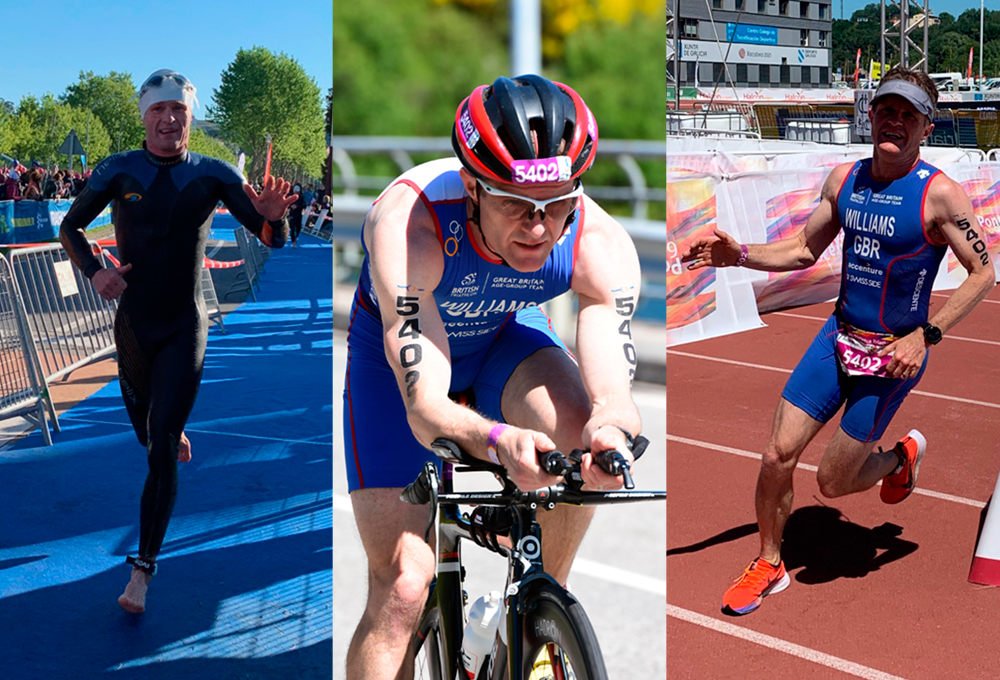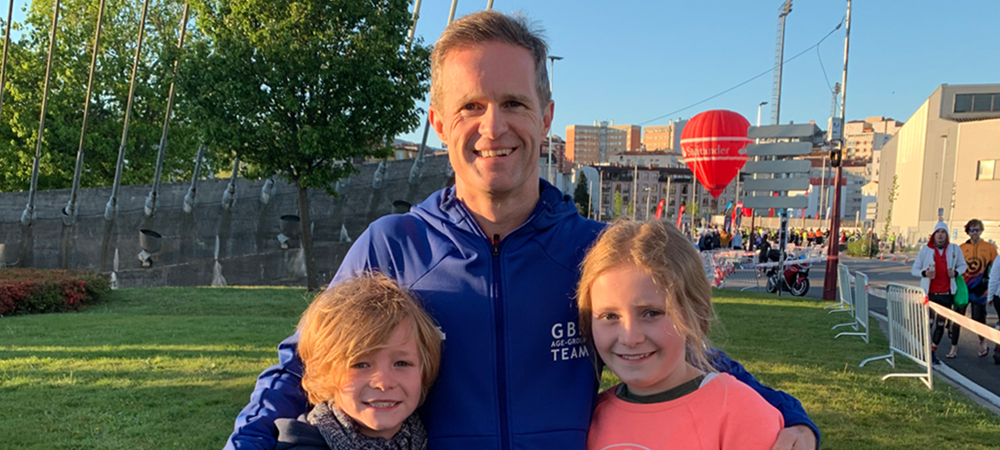Up to speed with the ITU World Championships

Marianne caught up with Ali about his recent experience at the ITU (International Triathlon Union) Long Distance World Championships.
First things first, the ITU Long Distance World Championships – what is it?
ITU is an international event. It takes place every year, and in a different country each time, with some of the world’s top elite triathletes vying for glory.
Outside of the elite competition, there’s an opportunity for people like me to represent their country for their age group: collectively known as ‘Age-Groupers’. For the GB team, there are 20 places per 5-year age range up for grabs.
To be eligible for qualification, you have to evidence a certain performance level in other long-distance triathlons (such as Ironman events) within the previous year. The best 20 from those eligible athletes are then selected as part of the GB team.
I was fortunate enough to make the cut, based on how I did at Ironman Wales last September.
And the “Long Distance” bit – how long are we actually talking?
If you’re familiar with half- and full-Ironman events, ITU Long Distance normally (depending on the specific event and location) sits somewhere in between.
For this event held in Pontevedra, north-west Spain, it was a 3km open water swim, followed by a 110km bike, then a 30km run.
Right okay, and why on earth would you want to do that?
Fair question! And one I do ask myself on a fairly regular basis. Most commonly in the cold, dark, small hours immediately before a race (long distance events have to start early), at the beginning of the water-based punch-up (when the possibility of drowning feels very real), and generally about halfway into the run (when most people you see are cheering you on from outside a pub or bar with a pint or ice-cream in their hands).
But those feelings are all out-weighed by the positives I get from training and competing in triathlons. I’ve always loved sport and physical exertion. It’s part of what makes me tick and is as important to my head as it is to anything else.
With triathlon specifically, though, it’s the mix of disciplines that really appeals. It keeps things interesting. I’ll find myself really into swimming for a while because it’s so technical with so much scope for improvement. Or it’ll be all about the purity and simplicity of running – you can do it anywhere, anytime and all you need is a pair of shoes. Then cycling might be in favour, whether that’s trail-riding or open country roads.
Plus, the great thing about combining three sports, is that there tends to be less potential for injury. The low-impact nature of swimming is the perfect antidote to running and keeps your upper body strong. And mixing running with cycling ensures balance in the leg muscles.
If you do pick up an injury, it’s rare that all training is out. It’s tricky to cycle or swim with a damaged shoulder, but you may be able to run. So when injury inevitably strikes and prevents progress in some areas, it can often present an opportunity to improve somewhere else.
So what about training, how much time do you put in for an event like this?
Never as much as I’d like! I’m pretty active in general, but in the months running up to an event I do ramp up the training. That said, the volume is probably at the low end of what it should be to be competitive at certain levels. I’d certainly like to train more, but I have to be realistic – and I value my marriage.
Around 10 hours a week average across the three disciplines is what I tend to aim for in the months leading up to a long distance event. To put that in context, professional triathletes, like the Brownlee brothers, will look to put in around 25-30 hours, plus strength training, structured recovery and rest, physio etc.
For most Age-Groupers, training has to revolve around work and family life. The key is to make whatever training you do as high quality as possible. If you’re training seriously, any session should always have one of three objectives:
- Will it make you faster?
- Will it make you stronger?
- Will it aid recovery?
Easier said than done, but it’s a useful guide to keeping your limited time productive.
10 hours is still a considerable chunk of time, how do you find it with a busy work and home life?
It’s surprising how you can eke out time to train when you really want to. It often means early starts (when others are tucked up), later finishes (when you’d rather be watching Netflix), and generally finding time to train when it’ll have the least impact on anyone else.
My work and home commitments mean any sort of training routine is pretty much out of the question. But, if you’re prepared to flex and adapt around what else is going on in any given week, it is possible to rack up the necessary quality hours.
The short sessions are easier to find time for – you can squeeze a quality hill run session in 45 mins at lunch, or if you can muster the impetus, at the crack of dawn. It’s the longer bike and run sessions, crucial for building endurance, that are harder to fit around work and family.
Sometimes you just need to be creative. That trip to see Grandma in Wokingham – perhaps I could ride there, or back, or both!?
You touch there on motivation. Do you ever struggle with that?
Definitely. Having a goal is generally the key to staying motivated with anything. That said, there are certainly times when an hour’s hill sprint or a four-hour solo ride in the rain (while the family settle down to a Sunday afternoon movie) is the last thing you feel like doing.
But I’d be restless and irritable (mostly with myself) if I didn’t just go out and do it. And one thing I can say for certain is that I’ve never come back from a run, cycle, or swim and thought ‘I wish I hadn’t done that’!
So back to the World Championships – after all the build-up, how was it?
It went well and I really enjoyed it (as did the rest of my family, which bodes well for the future!). Nerve-wracking from the off – frantic mass swim starts always get the adrenaline pumping – but, once into it, a great experience.
The town of Pontevedra was buzzing with crowds and flags of all nations – a welcome sight coming to the start of the run after a hilly bike section.
Any big names racing – the Brownlee Brothers?
Much to my 11-year old daughter’s disappointment, Alistair and Johnny weren’t there. But one of their arch-rivals, multiple world champion and Olympic silver medalist from London 2012, Javier Gomez Noya, was.
And in style too. He stormed the course from start to finish to take first place, and as a local boy received the sort of applause and adulation you’d expect.
How about you, did you get the result you were hoping for?
I finished in 6hrs 46minutes which placed me 19th out of 92 in my age group and 135th out of 736 overall.
Back in 2007, I actually qualified and competed as part of GB at the world championships in Lorient, France. Unfortunately, it was swim, bike, ambulance for me: I ended up in hospital with a broken wrist after coming off my bike. So this event felt a little like unfinished business.
On one level I was delighted just to cross the finish line, but to come in the top 20% was great. It’s never long before you start analysing the details of your performance though, and thinking if I could just improve this or that, just look where I’d be. I guess that’s what keeps me, and lots of others, coming back.

Sounds like a pretty decent result to me! Your kids must be proud?
So, when I first tried on my GBR trisuit complete with WILLIAMS emblazoned front and rear, I asked Joe, my 9-year old, what he thought…
“Hmmm, not sure Dad. Don’t think it’s really your colour.”
There’s no impressing some people.
It’s no better with Layla, my daughter, either…
If I happen to be asked about the event and I say anything about representing GB, there’s always a little voice that pipes up in the background:
“Amateur, it’s amateur, not professional.”
On the quiet though, I think they’re proud: Layla took my trisuit (washed) to school for an impromptu show and tell, and Joe tells me he wants to be better than Gomez.
So what’s next?
The plan’s to focus on shorter distance events for a while, and I’ve got a couple of races lined up. The time commitment is far less and a bit of relative downtime wouldn’t go amiss!
I’m hoping I’ll qualify for the European Long Distance Championships next year, but the build-up to that needn’t start for a while…
About Alastair
Alastair Williams
Founder and Creative Director
Ali co-founded mark-making* in 1995 after graduating from Lancaster University in Marketing & Visual Arts. Ali works closely with our clients to help bring clarity to their story, and oversees the wider mm* team to ensure it’s expressed effectively, with authenticity and coherence. Ali regularly speaks on the concept of Magnetic Brands, an approach to creating and building brands that embraces the power of being more human, in pursuit of both profit and positive impact. Ali leads mark-making’s work in helping ambitious organisations of all shapes and sizes build extraordinary and enduring appeal.